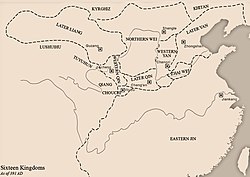Wei (Dingling)
Wei 魏 | |||||||||
|---|---|---|---|---|---|---|---|---|---|
| 388–392 | |||||||||
 Zhai Wei in 391 AD | |||||||||
| Status | Kingdom | ||||||||
| Capital | Huatai | ||||||||
| Government | Monarchy | ||||||||
| Tian Wang | |||||||||
• 388-391 | Zhai Liao | ||||||||
• 391-392 | Zhai Zhao | ||||||||
| Historical era | Sixteen Kingdoms | ||||||||
• Zhai Liao's last break with Later Yan | 387 | ||||||||
• Established | 388 | ||||||||
• Disestablished | 392 | ||||||||
• Zhai Zhao's execution by Western Yan | 393 | ||||||||
| |||||||||
Wei (Chinese: 魏; pinyin: Wèi) was a state of Dingling ethnicity that existed from 388 to 392, during the Sixteen Kingdoms period of Chinese history. It is often referred to as Zhai Wei to be distinguished from numerous other states named Wei in history. Its founder Zhai Liao had previously been vacillating between being a vassal of Later Yan, Western Yan, and Jin dynasty, and in 388, after his last overture to reconcile with Later Yan's emperor Murong Chui was rejected, he declared his own state, over the territory of modern central and eastern Henan. In 392, Wei, then under Zhai Liao's son Zhai Zhao, was destroyed by Later Yan forces. Because of its relatively small size and short lifespan, Wei is generally not included by historians among the Sixteen Kingdoms.
The rulers of Wei used the title "Heavenly King" (Tian Wang).
Rulers of Wei
| Temple names | Posthumous names | Family names and given name | Durations of reigns | Era names and their according durations |
|---|---|---|---|---|
Chinese convention: use family name and given name | ||||
| None | None | Zhai Liao (翟遼 zhái liáo) | 388-391 | Jianguang (建光 jiàn guāng) 388-391 |
| None | None | Zhai Zhao (翟釗 zhái zhāo) | 391-392 | Dingding (定鼎 dìng dǐng) 391-392 |
See also
- List of past Chinese ethnic groups
References
Ulrich Theobald. "Chinese History - Dingling 丁零". chinaknowledge.de. Retrieved 2015-11-09..mw-parser-output cite.citation{font-style:inherit}.mw-parser-output .citation q{quotes:"""""""'""'"}.mw-parser-output .citation .cs1-lock-free a{background:url("//upload.wikimedia.org/wikipedia/commons/thumb/6/65/Lock-green.svg/9px-Lock-green.svg.png")no-repeat;background-position:right .1em center}.mw-parser-output .citation .cs1-lock-limited a,.mw-parser-output .citation .cs1-lock-registration a{background:url("//upload.wikimedia.org/wikipedia/commons/thumb/d/d6/Lock-gray-alt-2.svg/9px-Lock-gray-alt-2.svg.png")no-repeat;background-position:right .1em center}.mw-parser-output .citation .cs1-lock-subscription a{background:url("//upload.wikimedia.org/wikipedia/commons/thumb/a/aa/Lock-red-alt-2.svg/9px-Lock-red-alt-2.svg.png")no-repeat;background-position:right .1em center}.mw-parser-output .cs1-subscription,.mw-parser-output .cs1-registration{color:#555}.mw-parser-output .cs1-subscription span,.mw-parser-output .cs1-registration span{border-bottom:1px dotted;cursor:help}.mw-parser-output .cs1-ws-icon a{background:url("//upload.wikimedia.org/wikipedia/commons/thumb/4/4c/Wikisource-logo.svg/12px-Wikisource-logo.svg.png")no-repeat;background-position:right .1em center}.mw-parser-output code.cs1-code{color:inherit;background:inherit;border:inherit;padding:inherit}.mw-parser-output .cs1-hidden-error{display:none;font-size:100%}.mw-parser-output .cs1-visible-error{font-size:100%}.mw-parser-output .cs1-maint{display:none;color:#33aa33;margin-left:0.3em}.mw-parser-output .cs1-subscription,.mw-parser-output .cs1-registration,.mw-parser-output .cs1-format{font-size:95%}.mw-parser-output .cs1-kern-left,.mw-parser-output .cs1-kern-wl-left{padding-left:0.2em}.mw-parser-output .cs1-kern-right,.mw-parser-output .cs1-kern-wl-right{padding-right:0.2em}
Historical Dictionary of Medieval China, p. 119, at Google Books